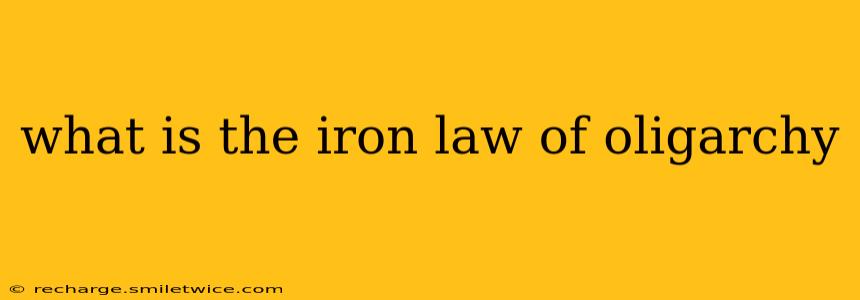The Iron Law of Oligarchy is a political theory that posits that all organizations, regardless of how democratic they may begin, will inevitably develop into oligarchies. This means power will become concentrated in the hands of a small elite group, effectively ruling the organization. This isn't necessarily a malicious takeover; it's a consequence of inherent organizational structures and dynamics.
What are the Core Principles of the Iron Law of Oligarchy?
The core principle revolves around the idea that the administrative demands of any large organization require a degree of specialization and expertise. This naturally leads to a division of labor, with certain individuals taking on more responsibility and influence. These individuals, often due to their skills, experience, or simply position within the structure, acquire more power than others.
This concentration of power isn't always actively sought; it often emerges organically through a process of:
- Centralization of Decision-Making: As organizations grow, efficient management requires delegating tasks. However, this delegation often leads to centralization of authority, concentrating power in the hands of those making key decisions.
- Professionalization of Leadership: Specialized roles and expertise are necessary to manage complex organizations. Individuals with these skills become indispensable and wield significant influence.
- Lack of Engagement from the Masses: The average member often lacks the time, resources, or interest to become actively involved in the organization's governance. This leaves the path open for the dedicated few to wield greater influence.
- Elitism and Social Hierarchy: Inevitably, a hierarchy emerges. Even in ostensibly egalitarian structures, distinctions in responsibility, skill, and perceived competence create natural power imbalances.
Is the Iron Law of Oligarchy Inevitable?
While Robert Michels, the sociologist who first formulated the Iron Law of Oligarchy, presented it as an essentially inevitable process, critics argue that it is an oversimplification. They point to successful examples of sustained democratic organizations and argue that:
- Active Member Participation: Organizations with high member engagement and robust internal democratic processes can mitigate the concentration of power. This requires active participation and a commitment to democratic principles from the broader membership.
- Strong Internal Checks and Balances: Clear structures and processes for accountability, transparency, and term limits can limit the power of any individual or small group.
- Technological Advancements: Improved communication technologies can foster greater member participation and transparency, making it harder for an oligarchy to form and maintain its grip.
- External Accountability: External factors, like regulation or public scrutiny, can force organizations to be more accountable and transparent, thereby limiting the potential for oligarchy.
What are some Examples of the Iron Law of Oligarchy in Action?
The Iron Law of Oligarchy is often cited as an explanation for the seemingly inevitable shift towards leadership by a few in various organizations. Examples may include:
- Political Parties: Even parties that start with grassroots movements often see a shift toward a more centralized and elite leadership structure over time.
- Trade Unions: Large trade unions can experience a concentration of power in the hands of union leaders and officials.
- Religious Organizations: Many large religious organizations exhibit hierarchical structures where a small group of leaders holds significant power.
How Can Organizations Combat the Iron Law of Oligarchy?
While the Iron Law of Oligarchy suggests an inherent tendency towards elite rule, it's not a preordained fate. Organizations can actively work against this tendency through:
- Promoting Transparency and Accountability: Open communication, clear financial records, and accessible decision-making processes can keep power more diffuse.
- Encouraging Broad Member Participation: Active involvement from the membership, through committees, voting, and feedback mechanisms, can prevent power from concentrating in the hands of a few.
- Implementing Term Limits and Rotation of Leadership: Limiting the time individuals can hold leadership positions helps to prevent entrenched power structures.
- Developing Robust Internal Checks and Balances: Internal oversight mechanisms can ensure accountability and prevent abuses of power.
The Iron Law of Oligarchy remains a significant topic of debate in political science and organizational studies. While its universality is questioned, it highlights crucial challenges in maintaining democratic principles within large organizations and offers valuable insights into the dynamics of power.
